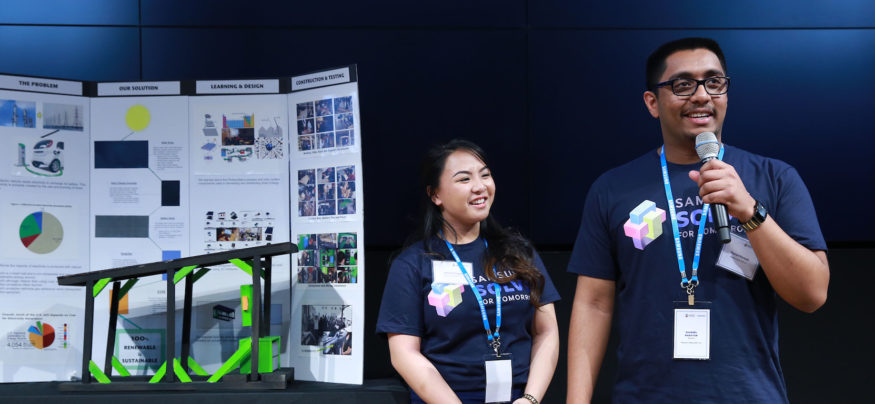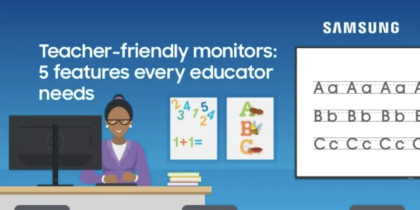Nationally, there has been a great push to get kids interested in STEM (science, technology, engineering and math) subjects, so they’ll be better prepared for future careers in the digital age. To help support those efforts, Samsung launched the national Solve for Tomorrow contest to give students the opportunity to experience firsthand how STEM can be applied to real-world issues and be used to make a difference.
The Solve for Tomorrow contest challenges public school students in grades 6 through 12 to use and expand their STEM skills to innovate a solution to a problem in their local community. Five groups of public school students from across the United States were recently named Grand Prize Winners, taking home $120,000 in technology for their school. The winners hailed from Colorado, Missouri, Virginia, New York and California. Winning projects included comfortable cardboard classroom furniture for special needs students, prosthetic enhancements for veterans and a smartwatch app for pedestrian safety.
Cost-Effective Prosthetics
The students at Horizon Middle School in Aurora, Colorado saw how hard it was for the veterans in their families to afford prosthetic limbs. They worked with local engineers and studied anatomy and prosthetics to research and create an artificial leg that would fit their test subjects’ needs and budgets. They learned that as an amputee’s residual limb changes over time, the amputee must get a new artificial limb, which adds to the ongoing cost. The students used a 3D printer to create models and the final product. Their work on this project has allowed them to help provide local amputees with the new limbs they need. This project was one of three chosen by a panel of judges based on the students’ live presentation.
Classroom Furniture for Students With Special Needs
After seeing their peers in with physical disabilities struggle to use classroom furniture, students at Ridgewood Middle School in Arnold, Missouri created reinforced cardboard furniture. They brainstormed ideas, worked with each student to learn their specific needs and partnered with a local engineering firm to explore and create custom furniture for the students in their school’s special education program. They are sharing their designs with other nearby schools so those schools can also create furniture to help their students learn in comfort and safety. This was another project awarded by the panel of judges.
A Solar-Powered Safety Net
A hiking and cycling trail in Virginia has been the site of a growing number of assaults and accidents — and victims have sometimes been unable to get help because of limited cell phone service. Students at Loudoun Valley High School in Purcellville, Virginia created a series of wireless and solar-powered nodes that alert emergency personnel of the location of an accident and the type of emergency service needed. The system then sends a message back to the victim when the original message has been received by police. This system could be replicated in other remote areas to help ensure resident and visitor safety. This project was also chosen by judges.
A Smartwatch App for Traffic Safety
After three of their classmates were hit by cars and killed crossing busy streets in Brooklyn, students at Brooklyn Technical High School developed a smartwatch app that uses the Doppler effect to detect an oncoming vehicle and alert wearers of potential danger. The students used mathematical models to ensure that the app would provide accurate warnings in a variety of conditions. This project was selected by Samsung employees as the Samsung Ambassador Choice Winner.
A Solar-Powered Car Charger
Students at Mission Valley ROP and James Logan High School in Fremont, California worked together to build an electric car charger that would provide a renewable source of power for the electric cars in their area. They studied how solar collectors work and designed a structure that would provide the right amount of power in a reasonable amount of time. Because their region has the highest number of electric vehicles in the country, this charger helps the local community meet their power needs without taxing the local power grid. This project was chosen as the Community Choice Winner decided by social media vote, garnering more than 12,000 votes on Twitter and Instagram.
Last October, more than 4,100 teachers submitted plans for how they would inspire their students to engage STEM. Five teachers per state (plus Washington, D.C.) were chosen to create activity plans that would allow their students to address a specified challenge in their community. One winner per state was then chosen, and all state winners received a Samsung Galaxy camera and Series 9 laptop to create videos of their projects. From that group of winners, 15 national finalists were chosen to present their projects in front of a live panel of judges at the contest’s Pitch Event, and a round of internal and public voting began.
All five of the Grand Prize Winners are invited to Washington, D.C. for an awards luncheon, meetings with their Congressional representatives and a tour of the White House on April 27. Students from the winning schools in California and Colorado have also been invited to present their projects at the White House Science Fair on April 13.
Through these projects and experiences, Samsung aims to inspire students to go even further in their STEM education. Working together to solve these problems will help students at all levels envision how they could pursue STEM careers — and make a difference.
Learn more about how you can incorporate STEM lesson plans into your classroom.







